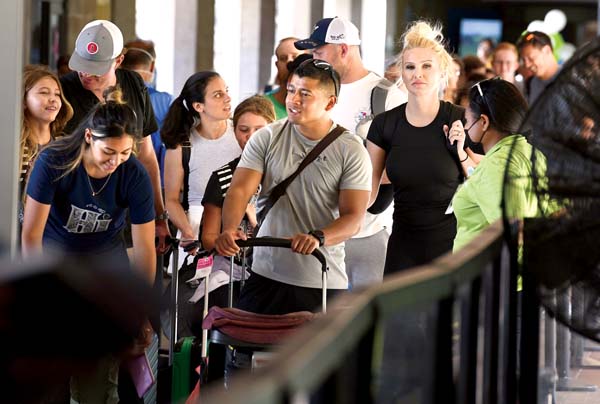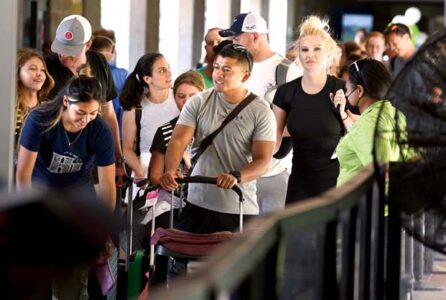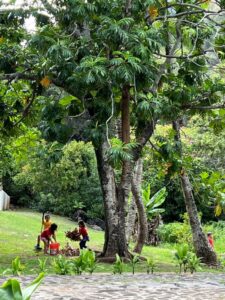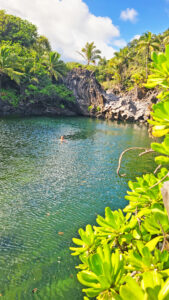Maui sees decline in visitors at end of busy summer season
State expecting soon return of international visitors, primarily to Oahu

Passengers wait in line to pass through the TSA screening at the Kahului Airport on Sept. 1, the day airport officials announced a number of changes that they hoped would cut down on wait times following a busy summer travel season. The Maui News MATTHEW THAYER photo
In the last month of a bustling summer that prompted airport officials to try and cut down on wait times, a total of 265,410 visitors arrived on Maui island and spent $472.9 million, according to recent reports by the state and Hawaii Tourism Authority.
The number of visitors was a 3 percent decline from the 273,638 who came in August 2019, prior to the pandemic, though spending was up 16.9 percent from the $404.7 million that visitors shelled out in August 2019.
August’s arrivals to Maui were also less than the 288,333 visitors who came in June and the 304,878 who arrived in July.
“Due to strong airlift, we are continuing to see recovery in the visitor industry with U.S. travelers leading the way on visits and spending,” Mike McCartney, director of the state Department of Business, Economic Development and Tourism, said in a news release Thursday. “The Japanese government reopened their country so we will see the return of the Japanese visitors beginning in October.”
International travelers, particularly from Japan, are one of the factors that local economists are hoping will help keep Hawaii’s economy afloat if the U.S. enters a recession, potentially curbing travel from Mainland visitors trying to save money amid high inflation and rising personal expenses.
But islands like Maui and Kauai that rely more on the U.S. market than Oahu and Hawaii island could feel the impacts of a decline in travelers.
Hawaii’s tourism economy as a whole was heavily dependent on U.S. visitors in August. Of the 829,699 visitors who came to Hawaii by air, more than 80 percent were from the Mainland, including 466,849 from the U.S. West and 217,214 from the U.S. East. (There were no out-of-state cruise activities in August.)
The $1.71 billion spent in August — a 13.8 percent increase over the $1.5 billion reported in August 2019 — was also largely driven by U.S. arrivals.
U.S. West visitors spent $864.7 million in August, a 49.3 percent increase over the $579.3 million visitors from this region spent in August 2019. Daily spending was also up 34 percent from $167 to $224 per person.
U.S. East visitors spent $507.3 million, a 33.8 percent increase over the $379.1 million they spent in August 2019. Daily spending of $243 per person was an 18.2 percent over the $206 per person spending in 2019.
Travelers came in far fewer numbers from international destinations — 28,384 visitors arrived from Japan in August, down 82.3 percent from August 2019, and spent $53 million in the state, down 77.6 percent from the $236.9 million spent in August 2019.
Canadian visitors, meanwhile, totaled 27,472 in August, down 4.2 from 2019, while spending $61.4 million, a 7.3 percent increase over 2019.
The expected soon increase in Japanese travelers is likely to boost Oahu’s tourism market, which has lagged much further behind its pre-pandemic numbers than Neighbor Islands where U.S. visitors have flocked back in droves.
Oahu had 457,495 visitors in August, a 20.4 percent decline from the 575,070 visitors who came to the island during the same month in 2019. Visitor spending, however, was still up at $799.4 million, a 9.2 percent increase over the $732 million spent in 2019.
Kauai, conversely, had 120,651 visitors in August, an increase of 0.5 percent over the 120,030 visitors seen in August 2019. Visitor spending was $191.2 million, 20.2 percent more than the $159 million spent on the island in 2019.
Hawaii island, meanwhile, had 147,290 visitors in August, 6.5 percent less than the 157,544 visitors it saw in 2019. Visitor spending totaled $231.4 million, a 19.9 percent increase over the $193.1 million spent on the island in 2019.
Molokai continued to have the least number of visitor arrivals in the state at 4,565 in August, a 6.1 percent decrease from the 4,860 visitors who came in 2019. Visitors there spent $2.4 million, up 37.8 percent from the $1.7 million spent on island in 2019.
Lanai, meanwhile, had 5,607 visitors arrive in August and spend a total of $13.2 million. This was down 27.5 percent from the 7,739 visitors and down 6.8 percent from the $12.4 million spent in 2019.
“Hawaii is on pace to a full recovery in 2025 with the return of international visitors,” McCartney said. “We will have to compete for the type of visitors we want as pent-up demand moderates and travel patterns settle in. While improving our destination and monitoring global events, we must be flexible and adjust our plans so that we can compete with other destinations as the world opens for travelers.”
McCartney said that DBEDT is projection 9.2 million visitors for all of 2022, which would represent an 88.5 percent recovery from 2019.
* Colleen Uechi can be reached at cuechi@mauinews.com.
- Passengers wait in line to pass through the TSA screening at the Kahului Airport on Sept. 1, the day airport officials announced a number of changes that they hoped would cut down on wait times following a busy summer travel season. The Maui News MATTHEW THAYER photo






